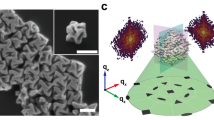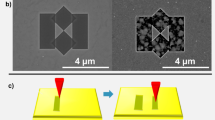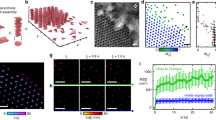Abstract
Metallic nanoparticles exhibit exceptional optoelectronic properties with applications in plasmonics, biosensing and nanomedicine1,2,3,4,5. Recently, new synthesis techniques have enabled precise control over the sizes and shapes of metal nanoparticles6,7,8, occasionally leading to morphologies that cannot be properly characterized using standard techniques. An example is five-fold-twinned decahedral Au nanoparticles, which are intrinsically strained as a result of their unique geometry. Various competing models have been proposed to predict the strain states of such nanoparticles. Here, we present a detailed analysis of the internal structure of a decahedral Au nanoparticle using aberration-corrected high-resolution electron microscopy and strain mapping. Our measurements confirm the presence of a disclination, which is consistent with the commonly accepted strain model. However, we also observed shear gradients, which are absent from the models. By comparing our local strain determinations with finite-element calculations, we show the effect of elastic anisotropy on the strain state in these nanoparticles.
This is a preview of subscription content, access via your institution
Access options
Subscribe to this journal
Receive 12 print issues and online access
$259.00 per year
only $21.58 per issue
Buy this article
- Purchase on Springer Link
- Instant access to full article PDF
Prices may be subject to local taxes which are calculated during checkout




Similar content being viewed by others
References
Barnes, W. L., Dereux, A. & Ebbesen, T. W. Surface plasmon subwavelength optics. Nature 424, 824–830 (2003).
Zia, R., Schuller, J. A., Chandran, A. & Brongersma, M. L. Plasmonics: The next chip-scale technology. Mater. Today 9, 20–27 (2006).
Willets, K. A. & Van Duyne, R. P. Localized surface plasmon resonance spectroscopy and sensing. Annu. Rev. Phys. Chem. 58, 267–297 (2007).
Zhao, J., Zhang, X. Y., Yonzon, C. R., Haes, A. J. & Van Duyne, R. P. Localized surface plasmon resonance biosensors. Nanomedicine 1, 219–228 (2006).
Jain, P. K., El-Sayed, I. H. & El-Sayed, M. A. Au nanoparticles target cancer. Nano Today 2, 18–29 (2007).
Nelayah, J. et al. Mapping surface plasmons on a single metallic nanoparticle. Nature Phys. 3, 348–353 (2007).
Pastoriza-Santos, I., Sánchez-Iglesias, A., García de Abajo, F. J. & Liz-Marzán, L. M. Environmental optical sensitivity of gold nanodecahedra. Adv. Funct. Mater. 17, 1443–1450 (2007).
Sánchez-Iglesias, A. et al. Synthesis and optical properties of gold nanodecahedra with size control. Adv. Mater. 18, 2529–2534 (2006).
Reyes-Gasga, J. et al. On the structure of nanorods and nanowires with pentagonal cross-sections. J. Cryst. Growth 286, 162–172 (2006).
Kirkland, A. I., Edwards, P. P., Jefferson, D. A. & Duff, D. G. The structure, characterization, and evolution of colloidal metals. Annu. Rep. Prog. Chem. C 87, 247–304 (1990).
Yacamán, M. J. & Avalos-Borja, M. Electron-microscopy of metallic nanoparticles using high-resolution and medium-resolution techniques. Catal. Rev.-Sci. Eng. 34, 55–127 (1992).
Gryaznov, V. G. et al. Pentagonal symmetry and disclinations in small particles. Cryst. Res. Technol. 34, 1091–1119 (1999).
Marks, L. D. Inhomogeneous strains in small particles. Surf. Sci. 150, 302–318 (1985).
Bagley, B. G. A dense packing of hard spheres with five-fold symmetry. Nature 208, 674–675 (1965).
Yang, C. Y. Crystallography of decahedral and icosahedral particles.1. Geometry of twinning. J. Cryst. Growth 47, 274–282 (1979).
Allpress, J. G. & Sanders, J. V. The structure and orientation of crystals in deposits of metals on micas. Surf. Sci. 7, 1–25 (1967).
Ino, S. Epitaxial growth of metals on rocksalt faces cleaved in vacuum. II. Orientation and structure of gold particles formed in ultrahigh vacuum. J. Phys. Soc. Japan 21, 346–362 (1966).
Ino, S. & Ogawa, T. Multiply twinned particles at earlier stages of gold film formation on alkalihalide crystals. J. Phys. Soc. Japan 22, 1365–1374 (1969).
Marks, L. D. & Howie, A. Multiply-twinned particles in silver catalysts. Nature 282, 196–198 (1979).
deWit, R. Partial disclinations. J. Phys. C 5, 529–534 (1972).
Howie, A. & Marks, L. D. Elastic strains and the energy balance for multiply twinned particles. Phil. Mag. A 49, 95–109 (1984).
Hofmeister, H. Forty-years study of five-fold twinned structures in small particles and thin films. Cryst. Res. Technol. 33, 3–25 (1998).
Chen, Q., Tanaka, M. & Furuya, K. Unusual crystallographic structure and its fluctuation of indium nanoparticles as-deposited and observed with HRTEM using the UHV-DC-TEM system. Surf. Sci. 440, 398–406 (1999).
Wu, Y., Chen, Q., Takeguchi, M. & Furuya, K. High-resolution transmission electron microscopy study on the anomalous structure of lead nanoparticles with UHV-MBE-TEM system. Surf. Sci. 462, 203–210 (2000).
Hÿtch, M. J., Snoeck, E. & Kilaas, R. Quantitative measurement of displacement and strain fields from HREM micrographs. Ultramicroscopy 74, 131–146 (1998).
Sutton, A. P. & Balluffi, R. W. in Interfaces in Crystalline Materials (ed. Brook, R. J. et al.) (Clarendon, Oxford, 1995).
<http://www.hremresearch.com>.
Hüe, F. et al. Calibration of projector lens distortions. J. Electron Microsc. 54, 181–190 (2005).
<http://www.comsol.fr>.
Huebner, K. H. H., Dewhirst, D. L., Smith, D. E. & Byrom, T. G. The Finite Element Method for Engineers (Wiley, New York, 2001).
Acknowledgements
We thank A. Sánchez-Iglesias for help with particle synthesis, L. Durand for help with the modelling and C. Gatel for help with image processing. We thank the IP3 project of the 6th Framework Program of the European Commission: ESTEEM (Enabling Science and Technology for European Electron Microscopy - Contract number 0260019) for financial support. M.E. thanks the Becas Faro program, part of the Leonardo da Vinci program of the European Union, for financial support. B.R.-G., I.P.-S. and L.M.L.-M. thank the Spanish Minsterio de Education y Ciencia (Grant Nos MAT2004-02991 and NAN2004-08843-C05-03) for financial support.
Author information
Authors and Affiliations
Contributions
C.L.J., E.S., M.E. and M.J.H. carried out imaging, analysis and modelling. B.R.-G., I.P.-S. and L.M.L.-M. carried out particle synthesis.
Corresponding author
Rights and permissions
About this article
Cite this article
Johnson, C., Snoeck, E., Ezcurdia, M. et al. Effects of elastic anisotropy on strain distributions in decahedral gold nanoparticles. Nature Mater 7, 120–124 (2008). https://doi.org/10.1038/nmat2083
Received:
Accepted:
Published:
Issue Date:
DOI: https://doi.org/10.1038/nmat2083
This article is cited by
-
Strain and crystallographic identification of the helically concaved gap surfaces of chiral nanoparticles
Nature Communications (2023)
-
Three-dimensional atomic structure and local chemical order of medium- and high-entropy nanoalloys
Nature (2023)
-
Design and synthesis of multigrain nanocrystals via geometric misfit strain
Nature (2020)
-
Atomically resolved Au52Cu72(SR)55 nanoalloy reveals Marks decahedron truncation and Penrose tiling surface
Nature Communications (2020)
-
Unexpected Kirkendall effect in twinned icosahedral nanocrystals driven by strain gradient
Nano Research (2020)



